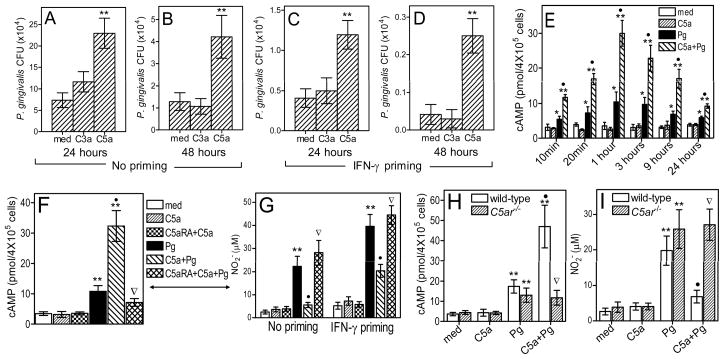Figure 1.
Immunosubversive effects of C5a on macrophages. (A–D) Peritoneal mouse macrophages were left untreated (A,B) or primed with 100 ng/ml IFN-γ (C,D) overnight, washed, and incubated with P. gingivalis (Pg; MOI=10:1) in the presence or absence of C3a (200 nM) or C5a (50 nM). Viable counts of internalized bacteria at 24 hours (A and C) or 48 hours (B and D) post-infection were determined by CFU enumeration. (E) Macrophages were incubated with medium only or with Pg in the presence or absence of C5a for the indicated times and assayed for induction of intracellular cAMP. (F) Similar experiment as in E, involving 1-hour incubation and the use of a specific C5a receptor antagonist (C5aRA; 1 μM), as indicated. (G) Unprimed or IFN-γ–primed macrophages were assayed for NO2− after 24-hour incubation with or without Pg and/or C5a, which acted in the absence or presence of C5aRA. (H–I) Similar experiments for induction of cAMP (H) and NO2− (I) using macrophages from both wild-type and C5aR-deficient (C5ar−/−) mice. Data are means ± SD (n = 3) from typical experiments performed three (A–D, F, G) or two (E, H–I) times yielding consistent results. *, P < 0.05 and **, P < 0.01 vs. medium (med) control treatments. •, P < 0.01 in C5a+Pg vs. Pg alone. Inverted triangles indicate significant (P < 0.01) reversal of C5a effects by C5aRA or C5aR deficiency.

